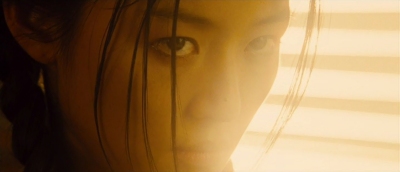
I actually prefer this version of Saya over the anime original. She’s equally as dedicated to the eradication of demons, but here she actually gives a damn about the people she’s protecting.
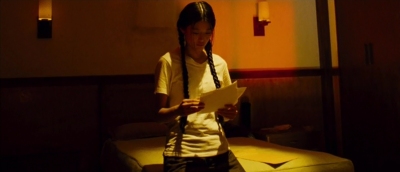
Seeing Saya’s living conditions, her lack of anything with sentimental value, an absence of hobbies or time killer activities, or even any indication that she stays in the same place for more than twenty-four hours, it’s clear that all Saya cares about is her mission.
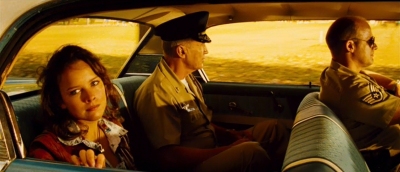
Most of the scenes in The Last Vampire are dominated by a single color. These early morning scenes in yellow being the most heavy handed.
Review by Jay Wilson Both versions of Blood: The Last Vampire have their moments and charms which makes them worth a viewing, but both also have an abundance of fatal flaws which keeps either from becoming truly great. What’s curious and makes both versions more interesting is watching them back to back and observing how very different they are, yet ultimately arrive at the same place. Like the anime, Saya is the presumed titular Last Vampire, fighting demons with her katana while aided by a secret organization on an American Air Force Base in Japan. The subway kill and the C130 runway chase are recreated fairly accurately, and the basic premise of Saya posing as a student in the American high school remains intact. Beyond that, pretty much everything else changes. The harmful changes revolve around—I’m going to be blunt—ill informed screenwriter’s desire to explain, explain, explain. And one of the most patronizing and offensive devices to accomplish this is the flashback. While flashbacks can be used effectively to enhance and add depth to a narrative, they typically end up putting the entire movie on pause to make a hack writer feel like he’s injected sophistication when all he’s really done is provide useless trivia at the expense of pacing. Case in point: Saya fights demons in the present. That is interesting. A flashback showing her sitting down, reciting recycled “who am I?” lines to her mentor 400 years ago is not interesting. In one mishandled flashback that might have added something, one of the demons loses an eye to Saya, but that rivalry is undermined because the flashback comes literally within five minutes of their final showdown. As a result, there’s no weight behind that battle. There’s no sense of a centuries-spanning vendetta or heightened danger. He and Saya might as well be meeting for the very first time, and he might as well be one of the dozens of other demons Saya has already killed, rendering that flashback pointless. For fledgling screenwriters, here’s a good rule of thumb: don’t use flashbacks. Period. Flashbacks are like stopping earth in its orbit, dooming us all to a slow death as the sun pulls us in to oblivion. No matter how vital you think your flashback is to your story, I can promise you it’s not vital enough. 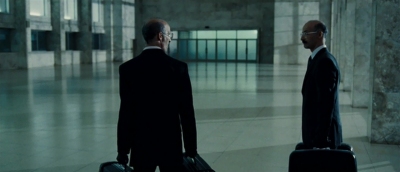
These guys don’t have any lines and are on screen for maybe a minute. They show up with briefcases and head towards Saya’s latest kill. Simply having identical twins do it makes the whole thing surreal and more memorable.
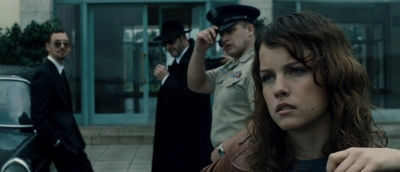
The difficulty with casting adaptations is audiences already have a solidified image of the characters. The cast of Blood is actually pretty damn good. Too bad the script sucked.
Neutral changes: In the anime, the monsters are called “chiropterans”, but here everyone is content to call them blood suckers or demons. David and Louis from the original have been replaced by characters named Michael and Luke who perform similar roles: hanging around looking conspicuous to let the audience know an underground organization aids and cleans up after Saya. The secret organization helping our vampiric heroine now has a name. The name, itself—like the names of its employees—is arbitrary. These things are basic machinations of the plot that the source material didn’t bother to develop or explore. “The Council” or nameless, “David” or “Michael”, “Louis” or “Luke” whatever. Who cares? With or without said label, we know the organization exists, and we know what these people do. Purists can go to hell. It’s not like they’re replacing hobbits with gremlins in Lord of the Rings. At one point we even get to meet the head of the organization who is known simply as “the elder.” The elder conveys information vital to the plot—namely informing Michael that the queen demon, Onigen, is in town—but it’s not vital that the elder, himself, deliver it. An underling or even a faceless voice on the end of phone would have gotten the job done too. It’s not like he ever comes up again. But, then again, the elder’s presence doesn’t hurt anything either. The middle aged (American) nurse from the anime is replaced by a young American teen named Alice, which kinda irks me because I suspect the decision has more to do with a cheap marketing notion that movies need young attractive American actors to sell stateside. So, I really don’t like Alice, but you know what? The anime took place on an American Air Force base in a high school, so she isn’t painfully out of place. That and I really didn’t like the overweight middle-aged nurse in the anime either. 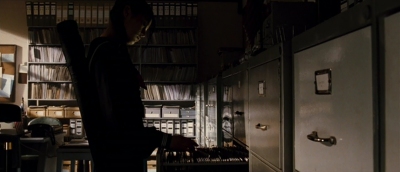
Director Chris Nahon (Kiss of the Dragon) and Cinematographer Hang-Sang Poon (Kung Fu Hustle) deliver some nice imagery such as this shot of Saya in dark shadows against the light backdrop of filing cabinets and bookshelves.
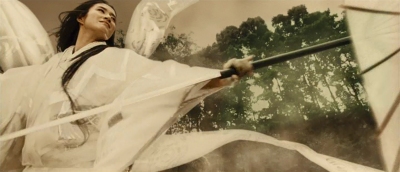
I love how those “tails” of fabric coming off Onigen’s kimono hover and float in the air as if they have a mind of their own. They make it look like she has a kind of symbolic skeletal wings.
Most fascinating of all, the whole tone and vibe of the live action version differs from the anime. The original is more suspense/horror focused, dwelling more on the buildup—curtains blowing in the wind, long corridors and dark empty rooms as Saya searches for her prey, a surreal walk through a crowd where a waking nightmare awaits, and characters behaving strangely while innocent soon-to-be victims remain oblivious. With the exception of the climactic final battle, the actual violence comes swiftly and then it’s over. The 2009 version, by contrast, plays more like a Hong Kong action movie with French music video sensibilities. A frame of vibrant colors, rapidfire cutting, and dynamic cameras show Saya defying physics as she takes on a horde of demons by her lonesome—kicking her sword out of its case so it flies up in the air where she catches it over her head; getting knocked clear across a rooftop only to spring back into action without even being winded; and using anything and everything around her as impromptu weapons/shields should she get separated from her trusty katana. And it’s here where the live action movie finds its paradoxical charm. To create its epic battles, Blood: The Last Vampire overindulges in subpar CGI and badly mismatched composite shots. Sometimes Saya’s movements eerily resemble stop motion as editing is blatantly utilized to speed up, slow down, and enhance Gianna Jun’s fighting. But somehow the sequences transcend their abundant technical shortcomings. As fake as it looks, there’s a genuine thrill as Saya races across the rooftops in pursuit of a demon, leaping through a neon sign, and bringing down a shower of sparks and debris as she lands. It’s just a fun ride loaded with energy and charm—two elements severely lacking in the technically superior action sequences of, say, G.I. Joe: The Rise of Cobra or Transformers: Revenge of the Fallen. 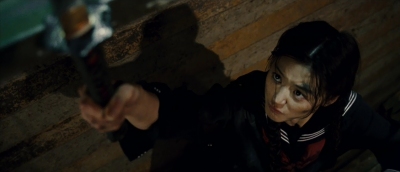
Personally, all I really require from a movie is likeable characters, interesting visuals, and a non-distracting sound track. For sophisticated stories, I tend to turn to literature.

All iterations of Blood (including Blood+) is a very diverse bundle of soaring peaks and precipitous valleys which makes recommending any of them difficult. It’s hard to predict which elements people will gravitate towards and key to.
With almost double the running time on top of a faster pace, this version of Blood covers far more ground requiring more content. Unfortunately, though, that materializes in the form of additional story tangents that do not develop in any meaningful way—internal conflicts haunt the Council, and the Air Force personnel investigate Michael, Luke, and Saya—but mercifully the film doesn’t pretend these complications do anything more than advance characters A and C to action set piece X in a timely manner. Flimsy plots aren’t necessarily bad as long as the film in question is unapologetic about it. And while Saya only kills only three unremarkable monsters in the original, the silver screen demands a bigger scale. Thus the 2009 Blood introduces the demon leader, Onigen, for a somewhat typical final battle that’s saved only by actress Koyuki’s charismatic performance and some nifty visuals. Not great by any means, but I dunno, it has an undertone of sincerity in its efforts to entertain which I find lacking in the cynical action blockbusters of Hollywood these days. Finally, the changes that actually improve on the source material: the small subtle touches. We knew the organization cleaned up after Saya, but here we very briefly see cleaners go to work with bizarre tools erasing the evidence. In the anime, we presume the title refers to Saya even though the traditional vampiric traits never manifest in her. Here, we do see her drink blood—blood given to her in bottles by the Council which also gives a few hints towards her working relationship with them. None of these things take up more than a few seconds, yet their effects ripple out and give life to this tale and its characters. Just seeing Saya in her small, bare, and unremarkable hotel room tells us so much about her. There’s a scene where Michael informs Saya that Onigen is nearby, and he poses the question, “have you ever thought about the future? When this is all over?” And Saya responds, “after this, there is no future for me.” With one glance at her place we knew the answer to that question long before it was asked. | ||||||||||||||||||||
|
| ||||||||||||||||||||
